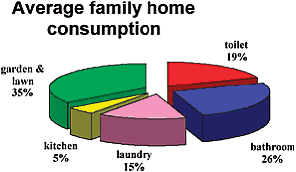Why Rainwater??
- Reducing water bills
- Average family home consumption data & graphs
- How much you can expect to harvest
Nature gives us our rainwater for free and once you have installed an efficient, rain harvesting system you use less mains water and can reduce your water bills.
Australians have used rainwater as one of their sources of water for all requirements - drinking, cooking, showering, laundry, toilet flushing through to watering the garden and now with evidence of our diminishing water supply it is more urgent than ever to have your personal safe and sustainable water supply.

Average Household Water Usage
Garden 30- 50% - (depends on size of garden and local water restrictions)
Toilet 8 - 19% - (depends on single or dual flush toilets)
Hot water 20 - 35% - (depends on washing clothes in hot water and shower times)
Laundry 10 - 20%
Shower / Bathroom 15 - 30%
Kitchen 5% - 75,000 up to 150,000 ltrs water consumption per person per year
Rainwater - The Untapped Potential
The average household has the potential to harvest 60,000 litres (60kl) of rainwater annually* - based on conservative data!
* (based on 120m2 roof area, 600mm rainfall a year with 90% co-efficient)
- Currently only around 21 per cent of Australian households (1,550,000+ households) have a rainwater tank installed.
- There is obviously, therefore, enormous scope to increase water tank usage in the cities and suburbs to supplement the mains water supply.
- In simple terms, 1 square metre of roof x 1mm of rainfall will collect 1 litre of water.
By using rainwater instead of mains water for garden and outdoor use, toilet flushing and laundry (washing machine use) we can reduce our dependence on mains drinking water consumption by up to 70 per cent.
Rainwater Tanks and Maintaining Rainwater Quality
- General tank maintainence advice
- Algal growth control
- Inlet, Outlet and Inspection Hole pointers
- Useful links for further information.
With proper management a rainwater tank can provide a supply of good quality potable (drinkable water).
Rainwater tanks should protect the water from contaminates like leaves, dust, pesticides, industrial pollution, vermin, insects and fertiliser sprays.
Tanks should be positioned in a shady spot, preferably away from trees to prevent leaves, etc., contaminating water.
All openings should be equipped with close fitting lids, or mesh screens.
The Inlet
Various inline screens and filters are available or can be made. Ensure that screens and filters are positioned so they are accessible for cleaning.
Openings should be screened so that the mesh gauze will fit on a collar about 50mm deep. This will allow effective water flow into the tank.
Avoid brass or copper screens as they may react with the galvanising of the tank. Ensure that screens are mosquito proof.
Overflow on Outlet
Treat this in the same way you do the inlet.
Inspection Hole
A close fitting lid which is readily removable is recommended.
Algal Growth
Light will stimulate the growth of algae in stored water. Try to exclude as much light as possible. Where an algal problem already exists, it is best to drain the tank and clean it.
The first rain after a dry spell may wash dust and other contaminants from the roof into the tank. It would be best to exclude this water by diverting the inlet pipe away from the tank. Follow-up rains should then be suitable for collection.
Further Information
SA govt information resources on rainwater tanks - https://www.sa.gov.au/topics/water-energy-and-environment/water/rainwater-tanks
Rainwater tanks and water quality (PDF) -http://www.health.gov.au/internet/main/publishing.nsf/Content/0D71DB86E9DA7CF1CA257BF0001CBF2F/$File/enhealth-raintank.pdf
view the Australian Drinking Water Guidelines - https://www.nhmrc.gov.au/guidelines-publications/eh52
Save Water in your home - http://www.sawater.com.au/residential/water-in-your-home-and-garden/save-water-inside-your-home


